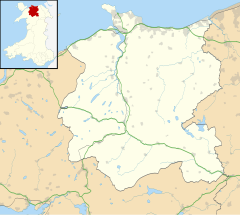Dolgarrog
| Dolgarrog | |
|---|---|
 A Pelton wheel in the grounds of Dolgarrog Power Station |
|
| Dolgarrog shown within Conwy | |
| Population | 446 (2011) |
| OS grid reference | SH768676 |
| Community |
|
| Principal area | |
| Ceremonial county | |
| Country | Wales |
| Sovereign state | United Kingdom |
| Post town | CONWY |
| Postcode district | LL32 |
| Dialling code | 01492 |
| Police | North Wales |
| Fire | North Wales |
| Ambulance | Welsh |
| EU Parliament | Wales |
| UK Parliament | |
| Welsh Assembly | |
Dolgarrog is a village and community in Conwy County Borough, in Wales, situated between Llanrwst and Conwy, very close to the Conwy River. The village is well known for its industrial history since the 18th century and the Eigiau dam disaster, which occurred in 1925. The population was 414 at the 2001 Census, increasing to 446 at the 2011 Census.
The village is served by Dolgarrog railway station, a halt on the other side of the river Conwy.
Believed to have been established around 1200 AD, Dolgarrog is said to have got its name from a flying dragon called Y Garrog. This mythical beast preyed on livestock and Dolgarrog (The Garrog's meadow) was the favourite meadow on which it swooped down from the heights above to carry off sheep. So serious were the losses that the farmers went on a dragon hunt armed with bows, arrows and spears.
One farmer, Nico Ifan, refused to go, claiming a dream had forewarned him the Garrog would cause his death. His fellow farmers laid a poisoned sheep's carcass on the heights above Eglwysbach across the river. The unsuspecting Garrog seized the bait, was caught and beaten to death.
Nico Ifan then came along to gloat over the dead dragon and cursed and kicked the corpse, whereupon the poisoned barbed wing of the Garrog pierced his leg thus fulfilling the death warning in his dream.
In the 1350s the Black Death took a heavy toll in the lower Conwy Valley, particularly among the bond tenants regulated by the King's officers from Aberconwy, Edward I's new English borough. Their visits and contacts in effect spread the disease. Some townships of villeins, or crown tenants, such as Dolgarrog, were swept away. People left their lands or hid, unable to pay the taxes on their holdings.
A man privy to Guy Fawkes' Gunpowder Plot is said to have lived in the house Ardda'r Myneich (Monks Hill), whose ruins lie in the fields above the road between Porthlwyd and Dolgarrog bridges. Dr Thomas Williams (1550–1622), rector of St Peter's Church, Llanbedr-y-Cennin, was charged with having papist sympathies. He had warned Sir John Wynn of Gwydir to stay away from the Houses of Parliament on that fateful day.
...
Wikipedia

